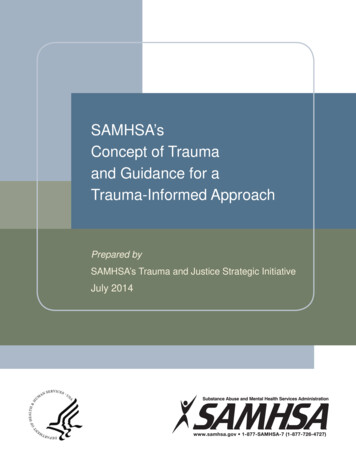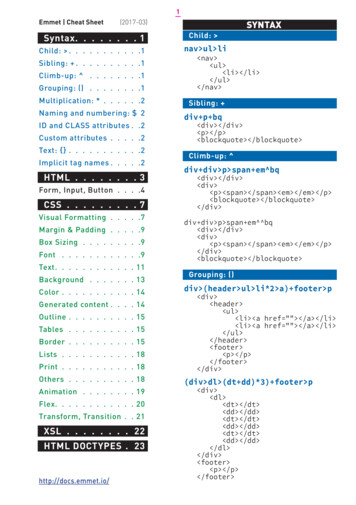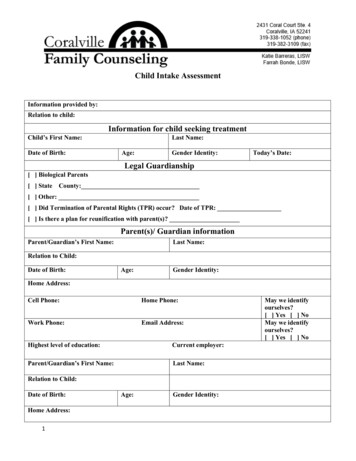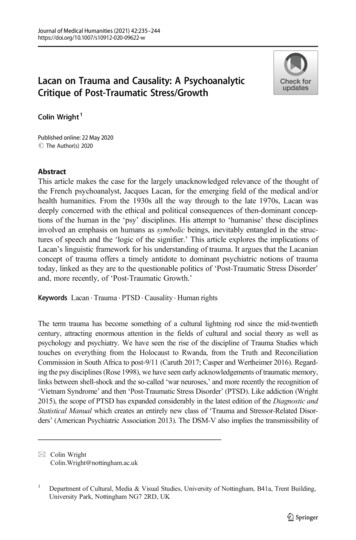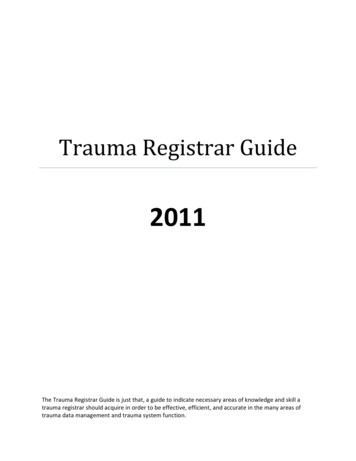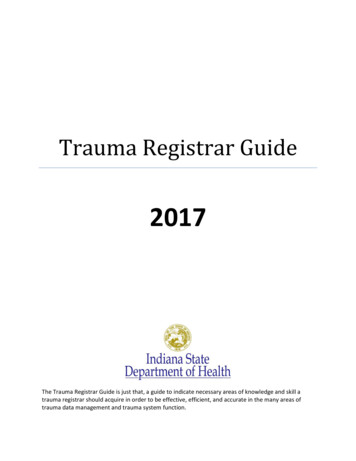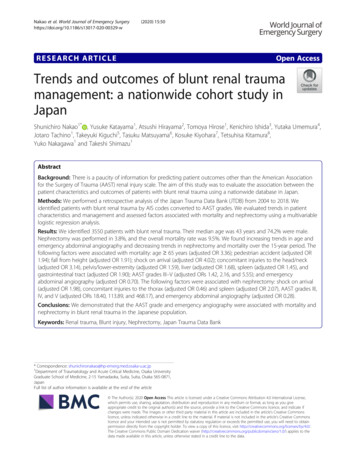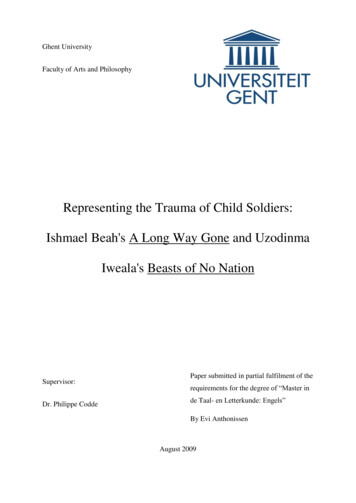
Transcription
Ghent UniversityFaculty of Arts and PhilosophyRepresenting the Trauma of Child Soldiers:Ishmael Beah's A Long Way Gone and UzodinmaIweala's Beasts of No NationSupervisor:Dr. Philippe CoddePaper submitted in partial fulfilment of therequirements for the degree of ―Master inde Taal- en Letterkunde: Engels‖By Evi AnthonissenAugust 2009
Anthonissen Evi2AcknowledgementsI first read Ishmael Beah‘s memoir A Long Way Gone: The True Story of a ChildSoldier last year in preparation for an exam. It was included in the reading list of the course―English Literature III: More Recent Period. Literary Witnessing in Cross-CulturalPerspective‖ which was taught by Dr. Stef Craps. I passed the exam and put the book on oneof the shelves of my bookcase, but I could not forget it. I continued thinking about the contentof the memoir and during the summer I came up with the idea that maybe I could use the bookfor my master‘s thesis. My supervisor, Dr. Philippe Codde, then pointed out to me that Iperhaps could contrast this memoir with a trauma novel. I chose Beasts of No Nation byUzodinma Iweala and after reading this powerful novel, I decided that these two books wouldform the core of my master‘s thesis. I was intrigued by how two completely different stylescan both accurately portray the same traumatic experience.First of all, I would like to thank my supervisor, Dr. Philippe Codde, for his goodadvice, for his corrections in the chapters that I sent and for keeping my interest in traumastudies alive with the course ―Postmemory and Postmodern: Third Generation JewishAmerican Trauma Narratives.‖ I would also like to thank Dr. Stef Craps for kindling myinterest in trauma studies and for bringing me into contact with Beah‘s memoir. My thanks tomy parents for being patient with me and for inventing the rule that students do not have tohelp in the household. I would especially like to thank my mother for proofreading everychapter and for always keeping me positive by asserting after each part that it was ―verygood.‖ My thanks to my boyfriend for listening to me and giving me good advice during thedifficult moments. My thanks also to my friends and particularly to those who were writingtheir master‘s thesis as well.
Anthonissen Evi3Table of Contents1.Introduction . 42.Theoretical Framework . 62.1. Definition . 62.2. Trauma Studies: a Historical Survey . 72.3. Contemporary Trauma Studies. 132.4. Trauma and Testimony. 212.5. Literature and Trauma . 283.Autobiography: Trauma, Truth and Fiction . 304.Introduction to Child Soldiers . 385.Ishmael Beah: A Long Way Gone: The True Story of a Child Soldier . 465.1. Introduction . 465.2. A Long Way Gone and LaCapra‘s Trauma Theory . 475.3. Controversy: Memoir and Truth . 605.4. Ishmael Beah‘s Social Objective . 646.Uzodinma Iweala: Beasts of No Nation . 676.1. Introduction . 676.2. Trauma Fiction and Post-traumatic Techniques. 676.3. Agu‘s Struggle for His Humanity . 736.4. The Possibility of Redemption . 787.Conclusion . 81
Anthonissen Evi1.4IntroductionIn my master dissertation, I will discuss two representatives of African traumaliterature: A Long Way Gone: The True Story of a Child Soldier by Ishmael Beah and Beastsof No Nation by Uzodinma Iweala. Even though these two authors use different narrativeforms, they both deal with the topic of child soldiers and the traumatic effects of thisexperience. The two writers also share their desire to bring attention to this problem and tomake Western readers understand this terrible and alien experience. According to MadelaineHron, one has a better chance of accomplishing this goal if one uses a child‘s perspective totalk about circumstances that are foreign to Western readers (29). And this is exactly whatBeah and Iweala do: Beah‘s protagonist is his younger self and Iweala‘s is Agu. Both arebright and tender-hearted boys who encounter inhumanity and who are confronted with thedarkest depths of their own soul. Hron argues that Western adult readers more readilyunderstand a confusing and problematic situation if it is being explained from a child‘sperspective and that they more easily have empathy for a protagonist that is a child than for anadult protagonist (29). She also believes that reading a book with a child‘s perspective maykindle in Western readers an interest for other books about the same culture and that it mayincrease their sympathy for that culture (29). And it is only through reading about andunderstanding a particular problematic situation, that one may want to help change thissituation. That is why Hron concludes her article with a proverb she invented for the thirdgeneration Nigerian writers who use a child‘s perspective in their books. Hron was inspired,she says, by the Igbo (an ethnic language in Nigeria) saying Ora na-azu nwa which can betranslated as ―It takes a village to raise a child‖ (45). For these writers, she then coined thephrase ―‗Nwa ndi na na-azu uwa‘: it is the children who are educating the global village‖(45). It is thus up to the young Ishmael Beah and to Agu to educate the adult Western readerabout the plight of child soldiers.
Anthonissen Evi5I will investigate in my master dissertation how a trauma novel and a memoir dealwith the problem of child soldiers. I will look at the differences and similarities between thetwo books and I will try to determine which literary narrative form is more adequate toportray this particular traumatic experience. I will begin my master‘s thesis with thetheoretical background of trauma studies in which I explain, among other things, the historyof trauma theory. Next, I will discuss the relation between trauma and autobiographicalwriting. I will look at some characteristics of narratives written by trauma survivors and I willdiscuss the role of fiction within these accounts. After that, I will introduce the topic of childsoldiers by explaining the reasons that cause children to become soldiers and their life withinthe army or rebel group. This chapter will enhance one‘s knowledge about child soldiers sothat one is better able to evaluate the authors‘ approach of the subject. I will then analyse bothbooks. In my analysis of Beah‘s memoir, I will focus on the application of DominickLaCapra‘s trauma theory and on the discrepancies that can be found in his account. The focusin my analysis of Iweala‘s trauma novel, on the other hand, will be on his use of posttraumatic techniques and on Agu‘s struggle to keep his humanity. In addition, I will alsodiscuss the objective the two writers have in mind. They both hope that their book will lead tosocial action and alleviate the plight of child soldiers. In my conclusion, then, I will look atthe differences and similarities between these two books and I will try to determine whichnarrative form (trauma fiction or realistic memoir) is more suitable to portray this particulartraumatic experience and which of the two is more socially effective.
Anthonissen Evi2.6Theoretical Framework2.1. DefinitionTrauma is generally defined as the response to an overwhelming event whichprecludes cognitive registration in the victim‘s mind at the time of its occurrence. Due to thefact that the event is not fully experienced when it happened, it belatedly returns in the formof uncontrolled and repetitive hallucinations, nightmares and other related phenomena. Theindividual is thus possessed by the traumatic event and its belated repetitions which resistbeing integrated into his or her consciousness (Caruth, Trauma 4-5). One of the most frequentof these uncontrolled repetitions are flashbacks, which are intrusive and recurrent reenactments of the traumatic event. These flashbacks can consist of images or sensations thatthe victim associates with the traumatic event or they can give him or her the impression thathe or she is experiencing the traumatic event all over again, since flashbacks can take the formof literal visual representations of the event. This exact visual quality can be related,according to Leys, to ―the cinematic possibility‖ of flashbacks which are experienced by thetraumatised individual as ―exact ‗returns‘ or ‗replays‘ of the traumatic incident‖ (241). Mosttrauma victims also suffer from traumatic nightmares. Like flashbacks, these nightmares canrepeat themselves, they can be experienced as if the traumatic event is happening again, andthey often consist of exact fragments of the traumatic past (Herman 39). Both flashbacks andnightmares can be evoked by small reminders or ―triggers‖ in everyday life (Vickroy 12). Thetraumatised individual can thus never be sure that traumatic memories will not appear again innormal circumstances (Herman 37). These visual traumatic memories, in nightmares as wellas in flashbacks, can give the trauma victim the impression that he or she is reliving thetraumatic event in the present. The feeling of the victim that he or she is ―back there relivingthe event‖ can cause the collapse of distance between the past and the present (LaCapra,
Anthonissen Evi7―Trauma Studies‖ 119), which leads to the breakdown of the normal course of life since, forthe trauma victim, it feels as if time stopped at the moment of the traumatic experience(Herman 37). Another danger of flashbacks and nightmares is the destructive potentialinherent in the repetition of trauma. Incessant repetition of the traumatic event, even yearsafter the experience, can, as Caruth points out, be retraumatizing itself (Unclaimed 63). Athird response to trauma is numbing, which can begin during or after the traumatic event(Caruth, Trauma 4). It is a ―state of detached calm‖ in which pain and terror disappear, but itis not a solution to trauma (Herman 42).2.2. Trauma Studies: a Historical SurveyOriginally, the meaning of trauma derives from the Greek word trauma, which means―wound.‖ It thus signifies an external injury to the body. However, the later psychologicalusage of the term trauma, as it was first used by Sigmund Freud, Pierre Janet, and theircontemporaries, describes not a bodily wound but a wounding of the mind caused by anunexpected shock (Caruth, Unclaimed 3-4). Freud defined the traumatic wounding of themind as a ―widespread rupture or breach in the ego‘s protective shield,‖ which is, as heexplains in Beyond the Pleasure Principle (1920), a barrier or a shield that defends the psycheagainst external stimuli (Leys 23). This rupture is thus the consequence of a traumatic eventwhich is, as stated before, not fully experienced by the victim at the moment of its occurrence.To explain to his contemporaries this refusal of the trauma to be assimilated in theconsciousness, Freud used the example of the train collision:It may happen that someone gets away, apparently unharmed, from the spotwhere he has suffered a shocking accident, for instance a train collision. In thecourse of the following weeks, however, he develops a series of grave physical
Anthonissen Evi8and motor symptoms, which can be ascribed only to his shock or whatever elsehappened at the time of the accident. He has developed a ―traumatic neurosis.‖This appears quite incomprehensible and is therefore a novel fact. The timethat elapsed between the accident and the first appearance of the symptoms iscalled the ―incubation period,‖ a transparent allusion to the pathology ofinfectious disease. . . . It is the feature which one might term latency. (qtd. inCaruth, Unclaimed 16-17)The trauma victim seems unharmed as he walks away from the accident, because he did notconsciously experience the crash as it happened. After a period of time, however, therepressed traumatic event belatedly returns to haunt the victim. The period between thetraumatic event itself and its effects on the traumatised individual, is termed latency by Freud.Cathy Caruth suggests that by using this term, Freud saw trauma as ―the successive movementfrom an event to its repression to its return‖ (Trauma 7). As will be explained later on, Caruthalso draws on the concept of the conscious unavailability of the traumatic event at the time ofits occurrence in her theory of trauma. Freud‘s initial research was focused on femalehysteria, which resulted in the development of his seduction theory. He claimed that repressedmemories of sexual abuse during childhood were the cause of hysteria in later life (Leys 4). Inthis theory, Freud asserted that the abuse during childhood itself was not traumatizing, butthat the dialectic of this first event with the delayed memory of it in adult life is. Leysaccurately describes this relationship in her study of the genealogy of trauma: ―a first eventthat was not necessarily traumatic because it came too early in the child‘s development to beunderstood and assimilated, and a second event that also was not inherently traumatic but thattriggered a memory of the first event that only then was given traumatic meaning and hencerepressed‖ (20). The two separate events are thus not inherently traumatic, but the dialecticbetween them, together with a period of latency, is. Freud termed this ―temporal logic‖
Anthonissen Evi9Nachträglichkeit, or ―deferred action‖ (Leys 20). To heal the trauma of his patients, Freudproposed to use the cathartic method, a technique in which hypnotism was used to retrieve―the forgotten, dissociated, or repressed recollections by bringing them into consciousness andlanguage‖ (Leys 4). In 1897, however, Freud had to abandon his seduction theory due tosocial pressure, since it implied widespread sexual abuse of children. Subsequently, heclaimed that the symptoms of female hysteria were caused by ―repressed erotic infantilewishes and fantasies‖ and not by real events (Leys 4). The condition of these women was thusthe result of unfulfilled wishes and their symptoms were seen as attempts to achieve wishfulfilment. After World War I, Freud focused his research on the returning soldiers who weretraumatised by their experiences in the war. These men suffered from what was then called―war neurosis‖ or ―shell shock.‖ However, most people did not recognise the severepsychological problems of these soldiers and they accused them of malingering. They weresent back to the front, and were sometimes even shot if they refused to fight. These shellshocked soldiers suffered from the same symptoms--such as nightmares and flashback--as didthe hysterical women, but Freud realised in Beyond the Pleasure Principle (1920) that hecould not describe the soldiers‘ traumatic nightmares as wish-fulfilment:Now dreams occurring in traumatic neuroses have the characteristic ofrepeatedly bringing the patient back into the situation of his accident, asituation from which he wakes up in another fright. This astonishes people fartoo little. . . . Anyone who accepts it as something self-evident that theirdreams should put them back at night into the situation that caused them to fallill has misunderstood the nature of dreams. It would be more in harmony withtheir nature if they showed the patient pictures from his healthy past or of thecure for which he hopes. (qtd. in Craps)
Anthonissen Evi10To explain these nightmares, Freud acknowledged the existence of the death drive, which is a―‗beyond‘ of pleasure‖ and which acts ―independently of and often in opposition to thepleasure principle‖ (Leys 23). In the same book, Freud also elucidated the concept ofrepetition-compulsion. This concept explains how the mind belatedly tries to prepare itself forthe traumatic event that has already occurred by constantly returning to the event innightmares and flashbacks: ―These dreams are endeavouring to master the stimulusretrospectively, by developing the anxiety whose omission was the cause of the traumaticneurosis‖ (qtd. in Craps). At the original occurrence of the traumatic event, the individual wasnot prepared for the shock and thus lacked the necessary anxiety, which led to a breach in theprotective shield. With these repetitions, the mind seeks to achieve ―retrospective mastery‖over the traumatic event by developing this anxiety (Whitehead 119). This repetition of thetraumatic event has two aspects, which makes it ambivalent. Either the victim can remaincaught in this constant repetition, which Freud termed melancholia; or repetition can help thevictim achieve catharsis, which Freud called mourning (Whitehead 87). To reach thiscatharsis, Freud stressed the role of narrative in Studies on Hysteria (1895): ―each individualhysterical symptom immediately and permanently disappeared . . . when the patient haddescribed that event in the greatest possible detail and had put the affect into words‖ (qtd. inWhitehead 87). One thus has to tell one‘s story to complete the process of recovery.A contemporary of Freud who also stressed the role of narrative in the recoveryprocess is Pierre Janet. Janet described trauma as the confrontation with a shocking andunexpected event which does not fit within ―the schemes of prior knowledge‖ (Caruth,Trauma 153). Since the mind cannot integrate the traumatic experience in an existingframework, it stores the memory of it in a different way, which causes it, as van der Kolk andvan der Hart explain, to become ―dissociated from conscious awareness and voluntarycontrol‖ (Caruth, Trauma 160). The trauma victim cannot consciously retrieve the memory of
Anthonissen Evi11the traumatic experience, but, due to the fact that the event was stored in the mind withoutintegration (and without change), the traumatic event returns after a period of time in all itsliterality in flashbacks and nightmares (Caruth, Trauma 153). This unavailability of memorytogether with the literal return of the traumatic experience refers to the central paradox oftrauma, which is that ―there is simultaneously too little and too much memory of the event‖(Whitehead 140). In his work on trauma, Janet made an important distinction betweentraumatic memory and narrative memory. Traumatic memory is the memory of a traumaticevent that was not fully grasped by the victim at the moment of its occurrence, which impliesthat it cannot be consciously recalled by the victim when he or she wishes to do so. Since it isnot integrated into the mind, this traumatic memory remains inflexible and therefore returnswithout change in repetitive visual flashbacks, nightmares and re-enactments that can betriggered by external stimuli (Vickroy 12). Whitehead even claims that traumatic memory―replays the past in a mode of exact repetition‖ (87). As opposed to traumatic memory,narrative memory is available to the individual in the form of a chronological story. The storyof the trauma can even vary each time the traumatised individual tells it, because narrativememory is ―capable of improvising on the past‖ (Whitehead 87). For Janet, the recovery fromtrauma is possible if the victim succeeds in transforming the traumatic memory into narrativememory. This transformation leads to the integration of the traumatic event as a particularmoment in the individual‘s chronological past, so that its influence on the present diminishes.Or, as Whitehead formulates it, ―Where traumatic memory repeats the past withoutconsciousness, narrative memory recognises the past as past‖ (140). This transformation oftraumatic memory into narrative memory, which is a social act since it requires a listener towhom the traumatised individual can tell his or her story, should make it possible for thevictim to improvise around the traumatic event and as such bring in some flexibility into hisor her account (Whitehead 141). In the therapy he proposed, Janet thus stressed the role of
Anthonissen Evi12narrative, since telling one‘s story leads to the integration of the traumatic experience into theindividual‘s normal mental framework so that he or she can understand what happened to himor her in the past.After World War I, interest in trauma declined and World War II did not change thissituation. It was not until the 1970s, when the Vietnam War veterans came back severelytraumatised, that trauma regained attention in the medical world. The large number ofreturning traumatised veterans issued new research into the possible traumatic effects of warand this research led to the acknowledgment of the phenomenon of Post-Traumatic StressDisorder (PTSD)--a new term to indicate what was previously known as shell shock orcombat fatigue (Caruth, Trauma 3). The first official diagnosis of PTSD appeared in the year1980 in the third edition of the American Psychiatric Association‘s Diagnostic and StatisticalManual of Mental Disorders. In this manual, PTSD was defined as ―an anxiety disorder withfour diagnostic criteria: A. Traumatic event. B. Reexperiences of the event. C. Numbingphenomena. D. Miscellaneous symptoms‖ (Leys 232). Category A of this definition, thetraumatic event, was described in the same edition as ―an event that is ‗generally outside therange of usual human experience‘ and as involving a ‗recognizable stressor that would evokesignificant symptoms of distress in almost everyone‘‖ (Leys 232). This definition of thetraumatic event recognised that PTSD was not only caused by war experiences, but also byother traumatic experiences such as rape, child abuse, incest, and natural catastrophes (Caruth,Trauma 3). After this, the interest in trauma studies grew and critics such as Cathy Caruth andDominick LaCapra received academic recognition.
Anthonissen Evi132.3. Contemporary Trauma StudiesA contemporary theorist of trauma is the aforementioned cultural theorist CathyCaruth. In Trauma: Explorations in Memory (1995), she mentions a generally accepteddefinition of trauma, which she describes as ―a response, sometimes delayed, to anoverwhelming event or events, which takes the form of repeated, intrusive hallucinations,dreams, thoughts or behaviors stemming from the event, along with numbing that may havebegun during or after the experience, and possibly also increased arousal to (and avoidanceof) stimuli recalling the event‖ (4). According to Caruth, this definition of trauma leaves outthe fact that the pathology cannot be defined by the traumatic event itself, since it ―may ormay not be catastrophic, and may not traumatize everyone equally‖; and it also cannot bedefined as a distortion of that event, because it achieves ―its haunting power as a result ofdistorting personal significances attached to it‖ (Trauma 4). Hence, the event itself does notcause the same trauma in everybody who experiences it. Consequently, Caruth states that―[t]he pathology consists, rather, solely in the structure of its experience or reception: theevent is not assimilated or experienced fully at the time, but only belatedly, in its repeatedpossession of the one who experiences it‖ (Trauma 4). Caruth thus stresses, as Freud didpreviously, that the traumatic event is so overwhelming that the mind cannot integrate it at thetime of its occurrence, which then leads to the belated return of the trauma in literal reexperiences such as flashbacks and nightmares. Caruth also agrees with Freud‘s theory thatthe breach in the protective shield is caused by the individual‘s lack of preparedness for theshocking event. In Unclaimed Experience (1996), she claims that the reason for this breach―is not simply . . . the literal threatening of bodily life, but the fact that the threat is recognizedas such by the mind one moment too late. The shock of the mind‘s relation to the threat ofdeath is thus not the direct experience of the threat, but precisely the missing of thisexperience, the fact that, not being experienced in time, it has not yet been fully known‖ (62).
Anthonissen Evi14The return of the traumatic event is then, according to Freud‘s explanation of repetitioncompulsion, an attempt of the mind to belatedly prepare itself for the shocking event and assuch try to achieve mastery over it (Caruth, Unclaimed 62).As explained before, Caruth agrees with Freud‘s theory that the traumatic event is notfully known by the victim at the time of its occurrence and that it constantly eludes the victimwhen he or she deliberately tries to recall it afterwards. Caruth claims that this impossibilityof completely grasping the event at the time of its occurrence, is part of the traumaticexperience itself: ―Central to the very immediacy of this experience, that is, is a gap thatcarries the force of the event and does so precisely at the expense of simple knowledge andmemory. The force of this experience would appear to arise precisely, in other words, in thecollapse of its understanding‖ (Trauma 7). This leads her to conclude that there is an ―inherentlatency within the experience itself,‖ since the traumatised individual does not repress orforget the traumatic event afterwards, but because he or she does not consciously experiencethe event itself as it happens (Trauma 8). The individual is thus dissociated from the event atthe time of its occurrence since the experience is so overwhelming that it cannot be registeredby the mind.This notion of dissociation in trauma is accurately described in the work of thepsychotherapist Bessel van der Kolk. He tries to explain trauma in a neurobiological way byinvestigating different brain mechanisms. The conclusion of his study is that the traumaticevent is not stored in the mind in the same way as normal memory, but that it is ―preserved inthe memory with a timeless accuracy that accounts for the long-term and often delayed effectsof PTSD‖ (Leys 7). Van der Kolk argues that traumatic memory is not the same as―declarative‖ or ―narrative‖ memory, which enables the individual to talk about past events,but that traumatic memory is more like ―implicit‖ or ―nondeclarative‖ memory, whichconsists of ―bodily memories‖ and which resists ―verbal-semantic-linguistic representation‖
Anthonissen Evi15(Leys 7). In Trauma Culture, Ann Kaplan explains van der Kolk‘s theory about traumaticmemory in a very straightforward way. She states that van der Kolk, who sees trauma as a―special form of memory,‖ argues that the traumatic event has ―affect only, not meaning‖(34). Since ―[o]nly the sensation sector of the brain—the amygdala— is active during thetrauma,‖ the traumatised individual can only feel emotions (34). He or she cannot make senseof the traumatic experience due to the fact that the ―meaning-making [sector of the brain] (inthe sense of rational thought, cognitive processing), namely, the cerebral cortex, remains shutdown because the affect is too much to be registered cognitively in the brain‖ (34). Notintegrated in the normal way, the traumatic event is ―etched‖ or ―engraved‖ in the mind in allits literality, which explains the belated but exact visualizations of the traumatic experience inflashbacks and nightmares. Due to this different way of encoding the trauma in the brain, thetraumatic memory is dissociated from normal memory and awareness. Hence, the traumaticmemory is cut off from normal consciousness and it is out of reach of voluntary recall. Thisfact bring us back to the central paradox of trauma: the traumatic event is etched in all itsliterality in the brain, but it is dissociated from ordinary integration and thus unobtainable forconscious recollection (Leys 239).Caruth‘s conception of trauma as being dissociated from consciousness challenges thetheory of recovery from trauma through the process of constructing a linear narrative, sincethe victim does not consciously experience the traumatic event as it happens, nor can he orshe voluntary recall it afterwards. However, Whitehead claims that although Caruth states thattrauma ―carries the force of a literality which renders it resistant to narrative structure andlinear temporalities‖ (5), her work seems to suggest that trauma can be presented in anarrative, but only in ―a literary form which departs from conventional linear sequence‖ (6).This experimental literary form should then be a narrative structure which ―does not succumbto closure and coherence, but retains within itself the traces of traumatic disruption and
Anthonissen Evi16discontinuity‖ (Whitehead 142). The reader is thus not presented with an uncomplicated linearand closed narrative, but with an experimental narrative that defies straightforwar
literature: A Long Way Gone: The True Story of a Child Soldier by Ishmael Beah and Beasts of No Nation by Uzodinma Iweala. Even though these two authors use different narrative forms, they both deal with the topic of child soldiers and the traumatic effects of this experience. The two write
